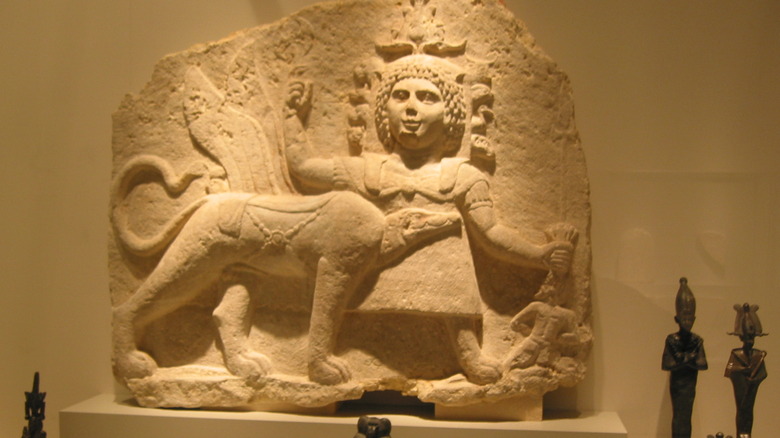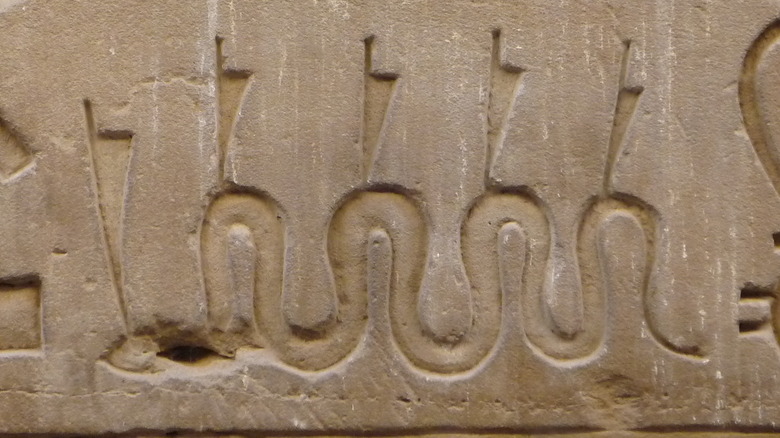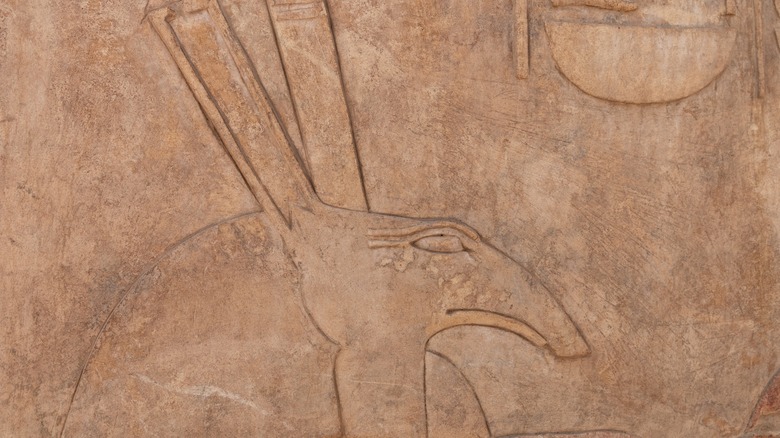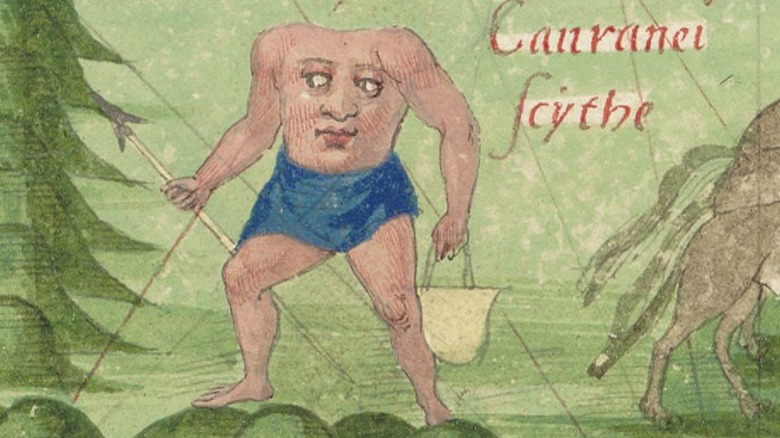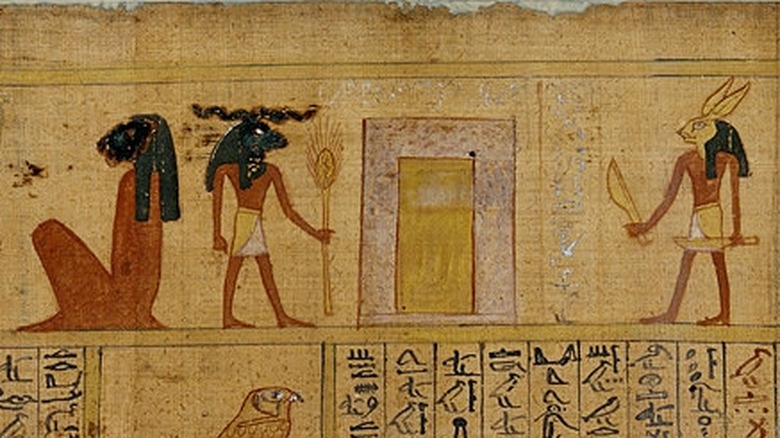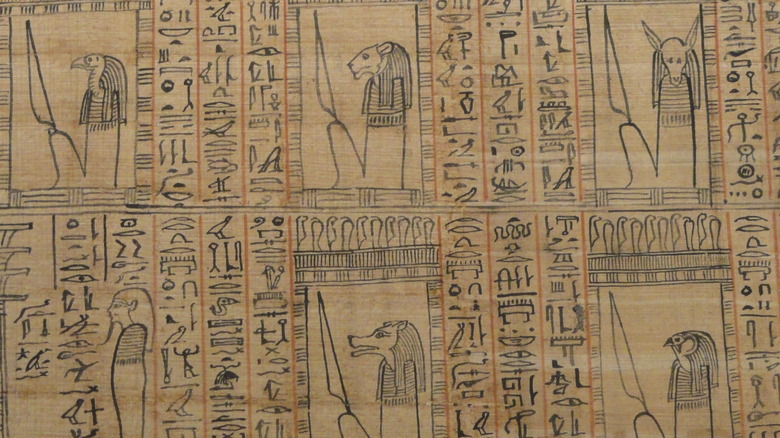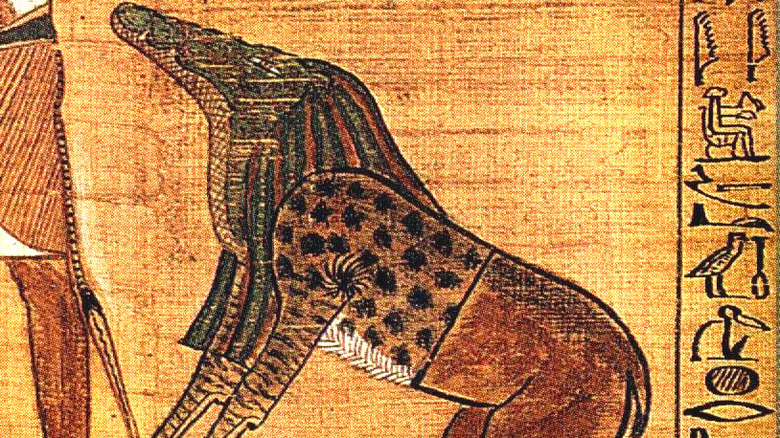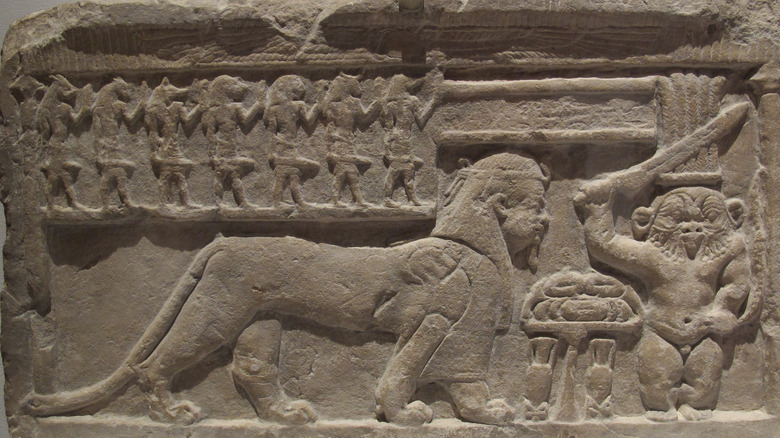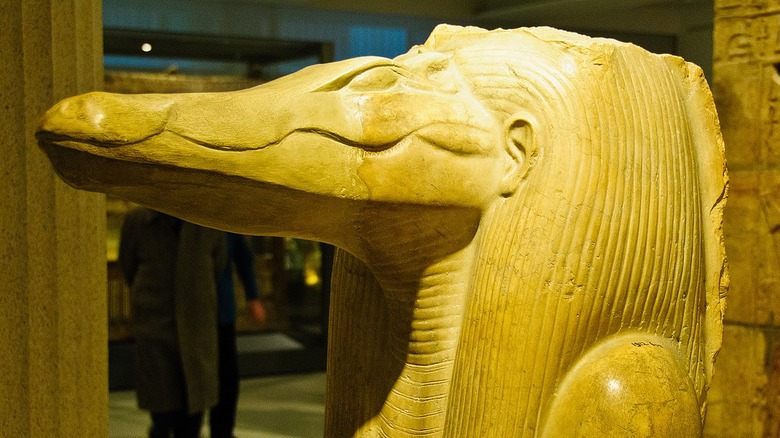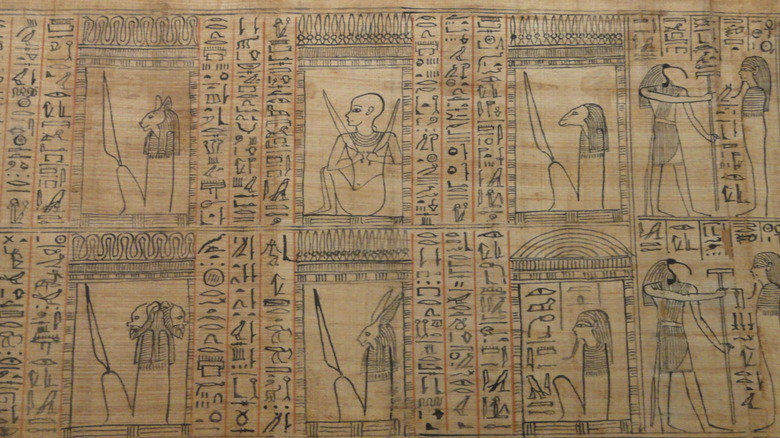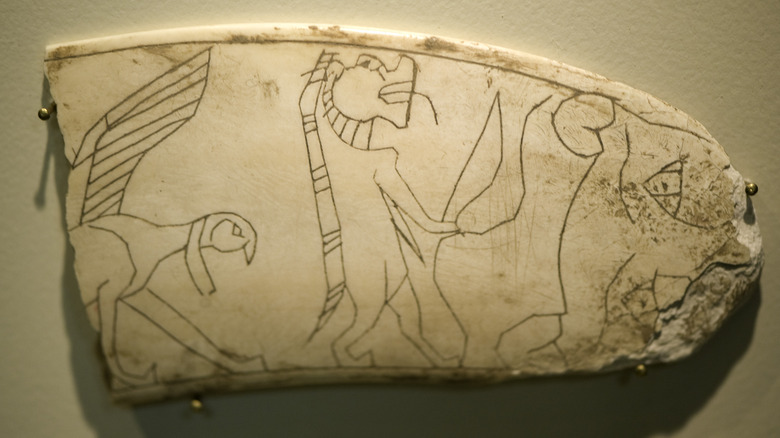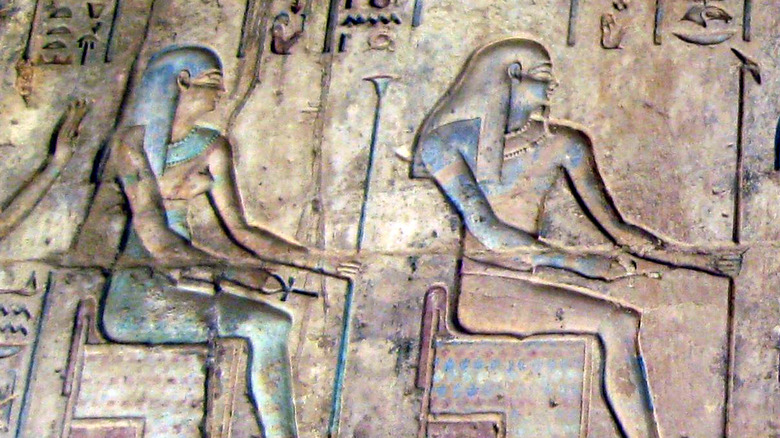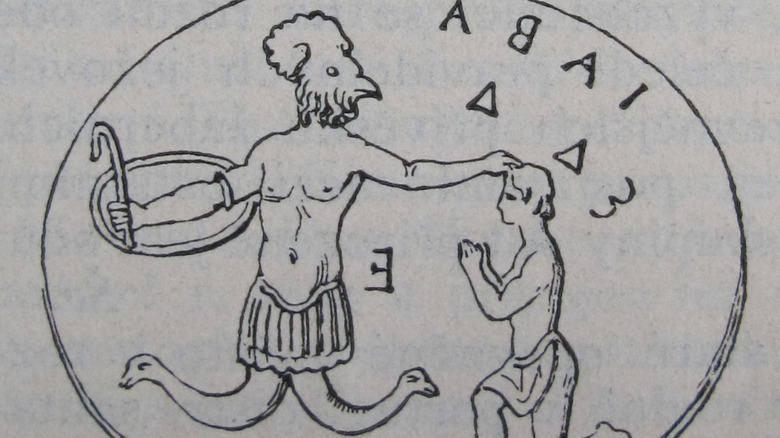12 Terrifying Ancient Demons In Roman-Egyptian Folklore
While ancient Egyptian religion is full of gods with names you might recognize, such as Ra, Osiris, Bast, Isis, and so on, they didn't have a proper word for what we would describe as demons. Nevertheless, they definitely conceived of a class of beings who were supernatural and possessed great power, but who were not worshiped as gods. These beings have subsequently been given the name of demons, but like in the Greek word "daimon" from which the English word derives, these demonic beings could be either good or evil, or some mixture of both.
By the period in which Egypt was under the control of the Greeks and Romans, these demons were thought to have an outsized influence on day-to-day life, and so magic spells and items such as amulets were employed to try to ward them off. Many of these spells are recorded in a collection of texts from the first century BCE to the 5th century CE known as the Greek Magical Papyri (because they're mostly written in Greek). Pulling from both mythology and these magical texts, here are some of the most frightening demons and monsters in all of ancient Egypt.
[Featured image by Magnus Manske via Wikimedia Commons | Cropped and scaled | CC BY-SA 3.0]
Apophis the serpent
In Ancient Egyptian cosmology, the concepts of good and evil are represented by the words ma'at and isfet. Ma'at is the idea of order and divine justice, and isfet is the chaos that roils outside the structure of creation. While most Egyptian demons of the Greco-Roman period kind of walk the line dividing those two ideas, one monstrous figure that dates far back into antiquity is a being of almost pure chaos: the enormous python Apep, called Apophis in Greek.
Apep was the physical embodiment of the very idea of isfet, or chaos, and as such was the archenemy of the sun god Ra, who was the representative of ma'at. Each day, Apep would lie in wait in the underworld for the sun god to travel through on his boat with the sun as part of his daily journey and then try to kill Ra. Fortunately, the god Seth stands guard on the front of the ship and kills Apep with a spear. The snake, however, as a cosmic being, can't be killed forever, so the process repeats day after day in the same cycle.
While Apep's position as a vast cosmic being puts him in a realm apart from most of the day-to-day demons on this list, he was still seen as a threat in the Roman period, and several prayers in the Greek Magical Papyri warding off the "unseen serpent" who brings disorder and darkness into the world.
[Featured image by Remih via Wikimedia Commons | Cropped and scaled | CC BY-SA 3.0]
Seth-Typhon
Even though Seth plays a role in stopping the chaos serpent from eating the sun, he himself was a god of disorder, the desert, storms, and violence, perhaps most famous for murdering his brother Osiris. Like many Egyptian gods, he was depicted as a person with an animal head, though historians are unsure of whether the head shown in art is meant to be a jackal, aardvark, giraffe, or something else. By the Roman period, however, Seth was typically depicted with a donkey's head.
The Greeks, who had a tendency to look for similarities to their own gods and monsters in the gods and monsters of the foreign nations they encountered, identified Seth with the monstrous chaos dragon Typhon, whom Zeus defeated in the primordial days of the Earth's history (which, yes, means Typhon should be more similar to Apep than Seth, but okay). This identification followed a general trend of making Seth increasingly evil over time, which was partly because his connection to the uncivilized outside world meant that he came to be seen as the god of foreign invaders like the Persians.
A spell in the Greek Magical Papyri calls Seth/Typhon the one "at whom the ground, the depths of the sea, Hades, heaven, the sun, the moon, the visible chorus of stars, the whole universe all tremble, the name which, when it is uttered, forcibly brings gods and daimons to it."
The Headless One
One of the stranger demons that is commonly invoked throughout the Greek Magical Papyri is a figure known only as "the Headless One" ("Akephalos" in Greek) and remains otherwise unnamed. Although this figure probably has his origins in the far reaches of Egyptian religion, he became very popular in the Greco-Roman period and was occasionally identified with gods including Osiris, the god of death, and Bes, a dwarven god who was a protector of households and one of the most commonly supplicated figures in the Greek Magical Papyri.
The Headless One's association with two of the most benevolent figures in Egyptian religion should make it clear that people were usually calling upon him for divine aid and protection, rather than praying to keep him away, like some demons. That said, the Headless One is terrifying in both appearance and power, being described as having faces on his legs or feet with mouths full of fire. As a representative of order and justice, he is said to be "the truth who hates the fact that unjust deeds are done in the world," and he shows his displeasure by making "the lightning flash and the thunder roll" as "the one who begets and destroys." It seems like even a benevolent god who had no head but whose feet were giant mouths full of immortal fire would not be something you wanted to summon, but it happens a lot in the Papyri.
Guardians
Egyptian demonology expert Prof. Rita Lucarelli explains that while there are some more cosmically monstrous figures like Apophis and Seth in Egyptian cosmology, most of what we would now consider "demons" tended to fall into two main groups: benevolent and malevolent, who are mainly distinguished by their function. The more benevolent demons tend to be stationary, tied to a particular place that their job is to watch over. Lucarelli calls these demons "guardians," and notes that they are often associated with a particular god, such as Osiris. As such, they can be seen as protectors of the gates of the Underworld, but they might also be tied to earthly locations like springs, rivers, mountains, or temples.
But just because these guardian demons worked for the side of good, it doesn't mean that they were safe to be around. They were fearsome and aggressive soldiers, typically depicted as human/animal hybrids, with the heads (or other body parts) of snakes, lions, scorpions, and so on. Also, to get the benefit of these demons' benevolence, you had to have some level of secret magical knowledge — their names, how to speak to them, and so on — or else you would be in considerable danger. Some of the guardian demons whose job was to protect earthly locations were also known to create natural disasters, bringing chaos and destruction to humans irrespective of whether they were good or bad.
Swallower of Sinners
The guardian demons of the Underworld served several protective functions, including guarding the gates, doors, and hallways of the netherworld, never leaving their posts, and only allowing in those who were permitted to be there. Others served as escorts for the souls of pharaohs and the other virtuous dead as they passed through the nether realm, as a reflection of the guardian demons who served to protect the body of the mummified god Osiris in the night hours between his mummification and revival by Isis and the other gods. These watcher demons not only had the hybrid animal form common to their class, but they were also typically armed, generally with knives or spears, though they could also be found wielding plants as weapons, or — strangest of all, but surprisingly common — snakes and lizards.
These demons were thought of as actual, physical presences and not just spirits, as is attested to not only by their physical descriptions but also by the names they were given. These protectors of the realm of the dead were commonly given names to reflect how fierce and aggressive they were, such as the Swallower of Sinners, the Rapacious One, or the Bellower. As stated before, it was essential for travelers of the afterlife to know these names and recognize the demons when they saw them so that they wouldn't be, you know, swallowed or stabbed with a lizard.
Ammut the Bone-Eater
The goddess Ammut (also spelled Ammit) is often described as a demon, and in many ways, she fits the role of the guardian demons of the Underworld. She did not have a cult of her own, but she had great power and was consequently feared. And that makes sense once you understand what her job was. The name Ammut is generally translated as "Devourer of the Dead," but she could also be known as the "Bone Eater" or the "Devourer of Millions." Another thing she has in common with guardian demons besides a job punishing the wicked in the afterlife is a hybrid animal form. Ammut was depicted as being a fearsome creature with a crocodile head, lion body, and hippopotamus legs, with these being the biggest, scariest, most human-eating animals known to the ancient Egyptians.
And being made of notorious man-eaters definitely fits her role in the afterlife cosmology. Ammut was the embodiment of the justice of the gods, sitting next to the scales of justice in the afterlife. If you know anything about the Egyptian afterlife, you probably know that the sins in the deceased's heart are weight against a feather, with Osiris serving as judge and Thoth as prosecuting attorney. An impure heart got eaten by Ammut, and the now-soulless dead would roam the Underworld aimlessly for eternity. There were, of course, spells and magic charms you could use to lighten the burden of your sins.
The Seven Arrows of Tutu
Some demons associated with gods were known to travel in packs, typically in groups of seven. One such deity was Sekhmet, a lion-headed goddess of both healing and pestilence, who could inflict both good and ill with her gang of demons known as the Seven Arrows. Another goddess associated with the Seven Arrows is the cat-headed Bastet, sometimes conflated with Sekhmet because they had feline heads in common. Under these two goddesses, who represented the righteous fury of the divine feminine, the Seven Arrows were deployed as plague-bearers and mass murderers, though they could just as often be deployed to protect against disease and evil spirits, more like the stationary guardian demons of the Underworld.
By the time of Roman Egypt, however, it was another deity — Tutu, or Tithoes as he was known in Greek — who received the title of "master of the demons." Tutu was depicted as a sphinx, with a human head and a lion's body, but his Seven Arrows were typically added in the form of animal heads coming out of his chest, neck, or back. These animals were usually crocodiles, lions, hawks, rams, or ibises, but he could also be shown being escorted by cobras. Despite the aggressive nature of the Arrows and their arsenal of knives and spears, the protective deities who commanded them kept them on a leash and made sure their destructive powers were focused on those who deserved it.
[Featured image by Sailko via Wikimedia Commons | Cropped and scaled | CC BY-SA 3.0]
Apathes, Great of Strength
One of the main elements that helps distinguish demons from what would be more properly termed gods is the fact that demons do not have cults of their own; that is to say, they don't have organized worship directed toward them with temples and priests and so on. However, the later you go into the Roman period, the more that begins to change. During this time, Egyptians started to attribute more and more of the struggles and misfortunes of life to the actions and influence of evil spirits. As a result, smaller, more localized cults did on occasion arise focused on the worship and appeasement of demons, especially those who might be strong enough to help drive off evil demons of disease and bad luck.
Naturally, the famous Seven Arrows of Sekhmet/Bastet/Tutu were top candidates for this kind of worship, most notably the demon considered to be the chief of the Seven Arrows, whose name in Greek was Apathes, from an Egyptian word meaning "Great of Strength." He was typically depicted with a crocodile head and sometimes his name was even written with the hieroglyph indicating he was a god, rather than the hieroglyphic knife or snake usually used to indicate protective demons. Over time, Apathes even begins to be worshiped as a protector completely separate from Tutu, who, in contrast, is almost downgraded from major god status due to his association with demons.
[Featured image by Graeme Churchard via Wikimedia Commons | Cropped and scaled | CC BY 2.0]
Wanderers and messengers
On the flip side of the violent but ultimately benevolent stationary guardian demons are the roaming demons who travel the world in packs, spreading misery and misfortune wherever they go. These groups of malevolent demons are given names such as wanderers, messengers, and slaughterers. Messengers tend to serve as agents of punishment sent by major gods like Osiris and Ra, who send them to enact violent justice on earth and in the afterlife alike. These messengers were feared for much of the ancient period in Egyptian history, from the time of the pharaohs well into the Roman period. The Book of the Dead, which was in use for over 1,000 years, talks about the messengers as the agents who inflicted punishment on the sinful dead in the Underworld.
Wandering demons were understood to be the cause of disease and illness, both physical and mental. For example, the demon Sehaqeq was thought to be the cause of headaches and is shown in art as a young man covering his eyes with his arms. Other demons caused nightmares or possessed people during their sleep, while yet others haunted houses and attacked people who walked by them. Many magic spells protecting against these wandering demons can be found on tombs, funerary inscriptions, and a large proportion of the Magical Papyri. By the Roman period, protective amulets meant to drive these demons away were common.
Slaughterers
Of the roaming class of demons, the groups known as the wanderers and the messengers sound relatively tame, with mundane names that sort of belie their roles as divine executioners. But there's no mistaking the role of the packs of demons known as the slaughterers. Their main job was to bring disease, plague, and death to the people of Earth, as well as punishment to the damned, as depicted in art from the tomb of Ramesses VI showing them beheading the bodies of dead sinners. Many of these slaughterers were associated with the goddess Sekhmet in her more malevolent aspect as a bringer of plague, and her Seven Arrows probably evolved from the idea of the lion goddess having an army of plague-inflicting demons at her beck and call.
The slaughterers were also associated with the decans, which were 36 groups of stars used in Egyptian astrology to divide the solar year into 10-degree chunks of the Earth's revolution around the sun and to mark the passage of the hours through the night. These stars or constellations were also thought to bring disease, so it's no surprise that by the Roman period, they were thought of as demons, and their malevolent influence was kept at bay by magical items such as amulets, inscriptions, and so on. By the late period, many other stars and constellations were thought to have a demonic influence on day-to-day life as well.
[Featured image by Rob Koopman via Wikimedia Commons | Cropped and scaled | CC BY 2.0]
Kek and Kauket
Another cosmic being of primordial chaos along the lines of the great serpent Apep is the god Kek, who is usually paired with his female counterpart Kauket. These two gods were part of a group of eight elemental gods called the Ogdoad, a set of four male-female pairs who represented the aspects of the primordial world at the time of creation. In all four pairs of the Ogdoad, the male deity was depicted with a frog head, while the female deity had a serpent's head. Kek and Kauket were the representatives of the chaos of the primeval darkness, obscurity, and the dangers of the night, a time of chaos in the absence of the truth-revealing light of the sun god, Ra. All eight gods of the Ogdoad were destroyed in the process of creating the world and subsequently hid away in the Underworld, where they aided in the processes of the natural world, including the flow of the Nile and, perhaps ironically, the rising of the sun.
In a bizarre modern twist, the coincidence of a frog-headed deity named Kek has led to this primordial god being adopted as a symbol by some members of the alt-right, who use the cartoon character Pepe the Frog and the word "kek" as memes, meaning that this ancient god is arguably more terrible now than he was in ancient Egypt.
[Featured image by S F-E-Cameron via Wikimedia Commons | Cropped and scaled | CC BY-SA 3.0]
Abrasax
A name that occurs frequently throughout the Greek Magical Papyri is that of Abrasax, a demon who is probably better known to modern readers by the later spelling Abraxas. In amulets and other inscriptions, Abrasax is represented as a figure with the head of a rooster, the body of a fully-armored Roman soldier holding a whip and a shield, and two snakes for legs. Through the Jewish numerological practice known as gematria, the value of his name adds up to 365, meaning that Abrasax was consequently seen as related to the sun and may even have been thought of as a solar deity. His name often appears in magic spells in conjunction with the names of other gods and numinous beings such as Iao, whose name was a corruption of the Hebrew god YHWH.
The figure of Abrasax originated not in Egyptian religion but among Gnostics in the second century CE, who viewed him as the true supreme god, overseeing 365 other lesser gods. By the time he was absorbed into Egyptian magic, however, he was little more than a demon invoked for magical purposes, and his name may be related to the word abracadabra, which is found in many ancient magical inscriptions.
